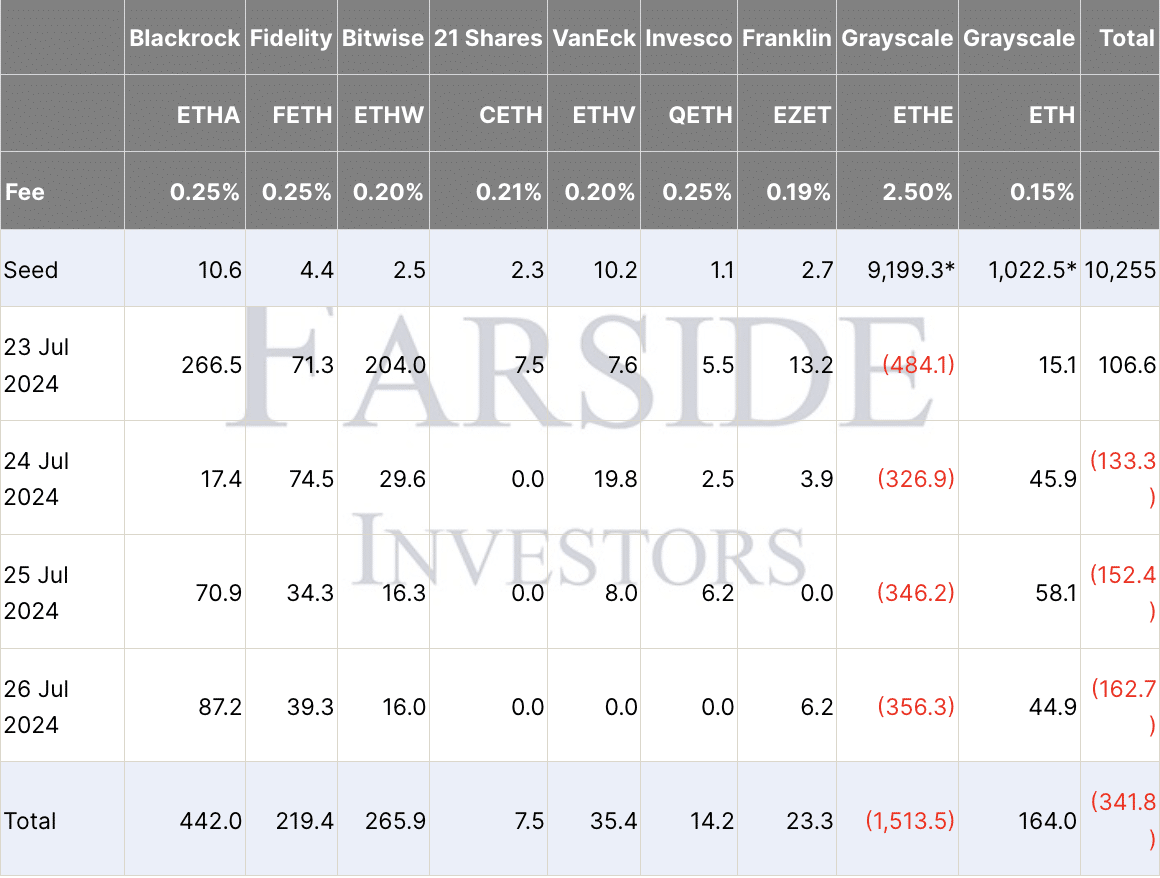U.S. spot Ethereum exchange-traded funds have had a mixed start this week, with net inflows into most ETFs overshadowed by significant net outflows from Grayscale’s converted fund, ETHE.
Data from Farside Investors shows that spot Ethereum (ETH) ETFs saw just over $162 million in total outflows on Friday, July 26, marking the third consecutive day of net negative flows. In contrast, spot Bitcoin (BTC) ETFs recorded $51.8 million in net inflows on the same day, continuing a trend of positive flows for three days straight.
The first ever spot Ethereum ETFs in the U.S. — nine products from eight issuers — started trading on Tuesday, July 23, following their approval by the Securities and Exchange Commission in May.
ETH ETFs’ first week
In the first week of trading, most of the newly launched Ethereum ETFs saw positive inflows, except for Grayscale’s ETHE, which experienced $1.51 billion in net outflows. ETHE’s outlfows have resulted in an overall weekly outflow of $341.8 million for the ETFs.
BlackRock’s ETHA led the pack in terms of inflows, generating $442 million worth of net inflows, followed by Bitwise’s ETHW with $265.9 million and Fidelity’s FETH with $219.4 million.
VanEck’s ETHV and Franklin Templeton’s EZET saw smaller inflows of $35.4 million and $23.3 million, respectively. 21Shares’s CETH received an inflow of $7.5 million only on launch day and saw zero inflows on the following three trading days.

Grayscale’s two Ethereum ETFs, explained
Major crypto asset manager Grayscale has introduced two spot Ethereum funds to the markets this past week, trading under the tickers ETHE and ETH. The Grayscale Ethereum Trust, ETHE, was initially launched in 2017 as a private placement, meaning it was only available to select investors and institutions in the U.S. Since 2019, the shares of the Ethereum Trust have been publicly traded OTC under the ticker ETHE. OTC trading of ETHE came with a 6-month holding period. However, since ETHE was converted to a spot Ethereum ETF last week, investors gained the ability to sell their holdings more freely.
The 2.5% management fee for ETHE — which is relatively quite high compared to fees of 0.25% or less from other ETF issuers — has driven investors to switch to competing products with lower fees, spurring the outflows from Grayscale’s fund. This situation is very much similar to what happened with Grayscale’s Bitcoin Trust (GBTC), which was also converted to a BTC ETF in January and then saw over $5 billion in outflows in its first month post-conversion.
Likely in expectation of this dynamic, Grayscale launched another ETF product this week, the Ethereum Mini Trust (under the ticker ETH). The new product boasts a competitive fee of 0.15%, positioning it as one of the most affordable spot Ethereum funds in the U.S. In contrast to ETHE, Grayscale’s Mini Trust saw inflows every trading day this past week, for a total of $164 million.
Grayscale’s ETHE, which held around $10 billion in assets (2.9 million ETH) before its conversion to an ETF, allocated $9.2 billion to its ETHE ETF product and just over $1 billion to its ETH fund.
The ETHE outflows, coupled with a more than 6% drop in the price of Ethereum since the ETFs launched, have reduced Grayscale Ethereum Trust’s assets under management to approximately $7.46 billion (2.28 million ETH), as reported on its fund page.
Ethereum ETFs vs Bitcoin ETFs: first week
It’s still early days, and if Grayscale’s spot Bitcoin ETF pattern is an indicator, the net outflows for ETHE might slow down. However, with an average net outflow of around $378 million per trading day this past week, ETHE’s assets could be depleted within a month.
In terms of the Grayscale effect, a significant difference between GBTC and ETHE is that GBTC shares were trading at a discount to the price of spot BTC when the GBTC ETF product launched. In contrast, ETHE’s “discount” — or the difference between the price of an ETHE share and the spot price of ETH — had closed by the time the spot Ethereum ETFs went live, partly explaining the stronger incentive to exit the fund.
Additionally, Bitcoin’s price had surged considerably before the spot Bitcoin ETFs launch in January, nearly doubling after approval expectations increased in October. In contrast, the price of Ethereum has been declining, falling more than 15% since the spot Ethereum ETFs were first approved on May 23.
“The major difference to me is the comparatively massive ETHE outflow. I think GBTC didn’t have that on day one because it was still at a meaningful discount when it launched,” noted James Seyffart, a Bloomberg ETF analyst, when comparing the outflows of the two products.
The the nine newly launched Ethereum ETFs saw total net inflows of $106.7 million on their first trading day, July 23, compared to $628 million in inflows for Bitcoin ETFs on their debut, according to data from SoSoValue
In terms of trading volume, the ETH ETFs saw around $1.1 billion in trades on their first day, while BTC ETFs saw $4.66 billion in trading volume on their inaugural day.
Throughout the first week, Ethereum ETFs generated a total trading volume of approximately $4.05 billion, compared to $7.85 billion for Bitcoin ETFs in their initial week.
Analysts anticipate that spot Ethereum ETFs will attract inflows ranging from 6% to 48% of those seen by Bitcoin ETFs in the first six months. This estimate suggests total inflows into Ethereum ETFs could reach between $1 trillion and $7.5 trillion by late January 2025.
At the time of writing, ETH, the second-largest cryptocurrency, was trading at $3,280. Its market cap is around $393 billion, with a 24-hour trading volume near $14.4 billion.
